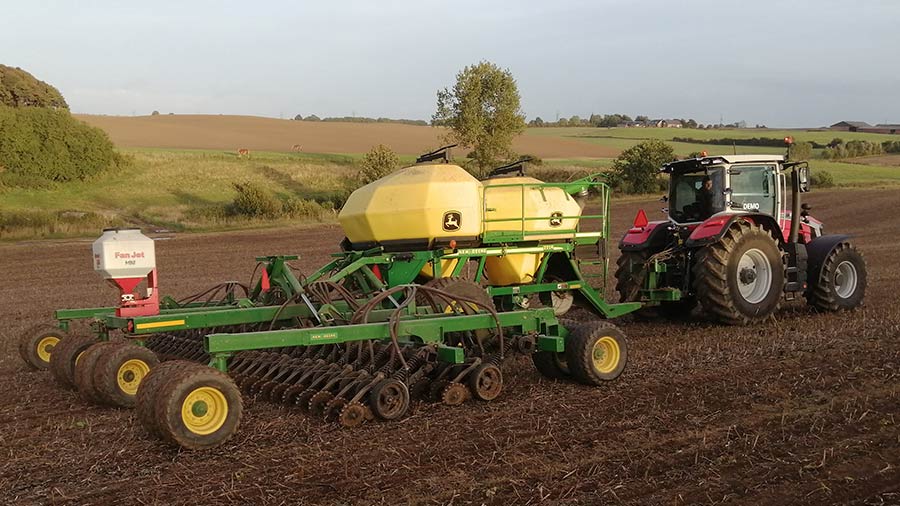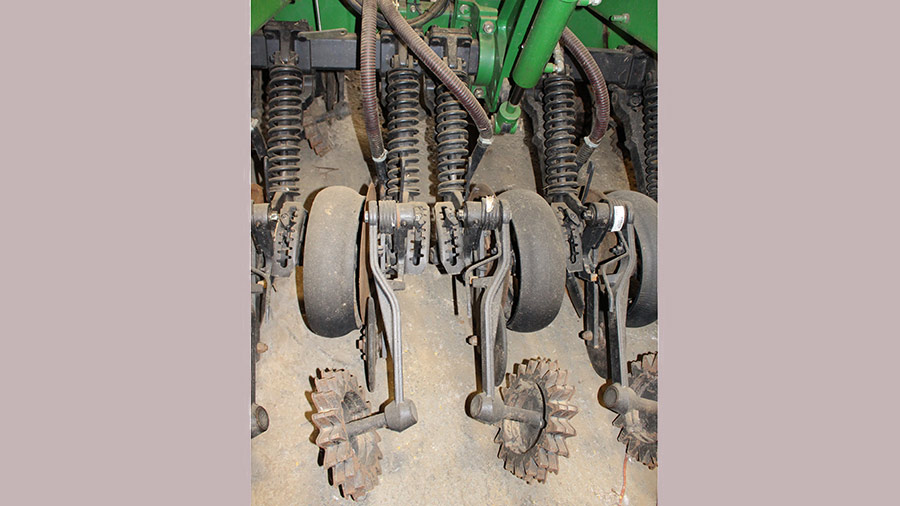Direct drills revisited: 9m custom-built John Deere 750A
 © Morten Mikkelsen
© Morten Mikkelsen After spending several years heavily modifying a 9m-wide, US-built John Deere 1890 drill for European conditions and UK roads, Leicestershire farmer Steve Heard put the implement – and the rest of his fleet – up for sale in 2021.
The drill was snapped up by Danish grower Morten Mikkelsen, who was in the market for something to replace his 2007-built 8m Horsch Sprinter ST that he’d been running for almost a decade on his farm near the city of Vejle.
See also: Driver’s View: Steve Heard’s John Deere 750A drill
“I was having problems getting a consistent seeding depth with the Sprinter and I knew the John Deere was superb in that regard,” says Morten.
“As well as reducing the transport width from 5m to 3m, Steve’s modifications involved fitting this drill with the same coulters as a 750A. The only alternative that can really match it for accuracy is the Avatar, which is basically a replica of the Deere design but far more expensive.
“The benefit of this version is that it has a split hopper, which standard 750As do not.”
Having arrived in the summer of 2021, it has now completed two full seasons and, in general, Morten is very pleased with his investment.
Gaining a metre in working width was no problem, as he had not drilled tramlines for years. And, combined with the 6,000kg hopper, it means he has the capacity to cover his 370ha of arable land in a week.
“The drill is too big for me, really, but it means I can be picky about my drilling date to go in perfect conditions. Because of that, seed placement is usually spot-on.
“I think it works best below 10kph, as there’s less soil throw and the coulters stay in the ground rather than jumping about.”
It also does a good job of closing the slot, something previous owner Steve Heard had found occasionally challenging on his heavier clay in less favourable conditions.
Custom John Deere 750A (2014) specs
- Width/spacing 9m/166mm
- Coulters/pressure Discs/260kg
- Hopper 6,000 litres, split 3,500 litres/2,500 litres
- Price paid £45,000 (in 2021)
Change of system
The arrival of the 750A on the farm completed Morten’s transition to a low-input system, having stopped ploughing in 2012 and started direct drilling – albeit with the strip-till Sprinter – in 2017.
The rotation includes wheat, barley, oats, ryegrass for seed, white clover and spring beans, and yields have remained stable through each stage of the process.
“There has been practically no impact on the winter crops or spring beans, and germination is far more uniform with the no-till system compared with when I ploughed and power harrowed,” he says.
“But I have noticed that spring barley benefits from prior harrowing. Without that, yields tend to drop by 1t/ha. Fortunately, the drill works fine into harrowed ground.”

© Morten Mikkelsen
Problems
However, it hasn’t been completely trouble-free and the John Deere metering system, which is different to the Accord setup of the 750A, has proved particularly problematic.
Morten says: “It’s a rubbish design and far too difficult to clean after it’s had fertiliser in, so it has gradually deteriorated and gone rusty.
“After I bought the drill, I did a bit more research and found lots of other John Deere 1890 owners on YouTube talking about how crappy the system is.”
So, top of the priority list is to upgrade to a stainless-steel metering house from North Dakota firm Red E. The same outfit also sells blockage sensors, for which Morten was quoted $10,000 (£8,000).
“I’ve had trouble with blocked pipes, but I think the hydraulic pump was part of the problem, as there was insufficient air flow. I replaced it in the spring, so I’ll find out if the issue has been solved this autumn.”
Despite the North American design, sourcing spare parts has been no problem through John Deere’s European headquarters at Mannheim in Germany.
Improving the ease of coulter servicing is next on the agenda, with the bearings on each of the 54 row units proving hard to grease.
Likes and gripes
Likes
- Accurate, uniform sowing depth
- Low power requirement
- Closes the slot well
- Custom build has added split hopper
Gripes
- Maintenance is difficult
- John Deere metering unit is poor
- Hydraulic pump problems

